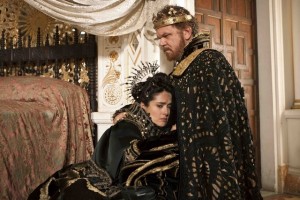Tale of Tales
Posted on April 28, 2016 at 5:15 pm

The visually striking “Tale of Tales” is based on three stories from Giambattista Basile that go back a hundred years before the Brothers Grimm. Basile, whose book was subtitled “entertainment for little ones” was the first person to write down these folk tales, including early versions of Cinderella, Rapunzel, and other classic stories. The three tales here, inspired by Basile’s stories, have fairy tale elements — wishes, magic, monsters, a princess to be won by whoever gives the right answer, a queen who will do anything to have a child. And there are lush, gorgeous, and wildly imaginative images. But these are not for children. These are straight out of the primordial ooze of the collective unconscious. These are not so much stories about enchantment as they are about desire, hubris, terror, all of the the deepest and most untamed emotions. Don’t expect anyone to live happily ever after.
The Queen of Longtrellis (Salma Hayek) is inconsolable. She wants a child. A wizard offers her a solution. If she eats the heart of a sea monster, prepared for her by a virgin, she will become pregnant, but it will be at the cost of a life. She agrees. And her husband, the king (John C. Reilly) is killed capturing the monster. The virgin prepares the heart, and the queen devours it. She and the virgin both become pregnant and deliver identical sons.
The King of Strongcliff (Vincent Cassel) is a libertine. He hears the voice of an old woman singing (Hayley Carmichael) and, believing her to be young and beautiful, tries to get her to agree to sleep with him. She agrees, provided that they keep the lights off. But he peeks and horrified by her appearance, has her thrown out of the window.
And the King of Highhills (Toby Jones) has a beautiful and devoted daughter, Violet (Bebe Cave). She prepares a song to show her love for her father but as she performs, he is distracted by a flea on his hand, which fascinates him so much that he keeps it for a pet, feeding it and fattening it up until it is the size of a pig. When it dies, he has it skinned and offers Violet’s hand in marriage to the first one who can correctly identify the animal it came from. But the one who knows the answer is an ogre.
Each of these stories explores issues of pride, selfishness, and greed. The Queen wants more than a child; she wants all of his love. The old woman wants superficial beauty and the power it can bring and the lecherous king wants sex and a beautiful wife. A woman is consumed — literally — with jealousy. Another king can’t see the love of his daughter because he is preoccupied with his grotesque pet. Director Matteo Garrone, with his first English language film, gives the stories a hallucinatory quality with rapturous images on the brink between dream and nightmare.
Parents should know that this film includes nudity, sexual references and situations, monsters, fairy tale violence and explicit and disturbing images.
Family discussion: How do these fairy tales differ from the ones more familiar to modern audiences? How do each of these stories deal with the theme of pride?
If you like this, try: “The Brothers Grimm” and “Time Bandits”
